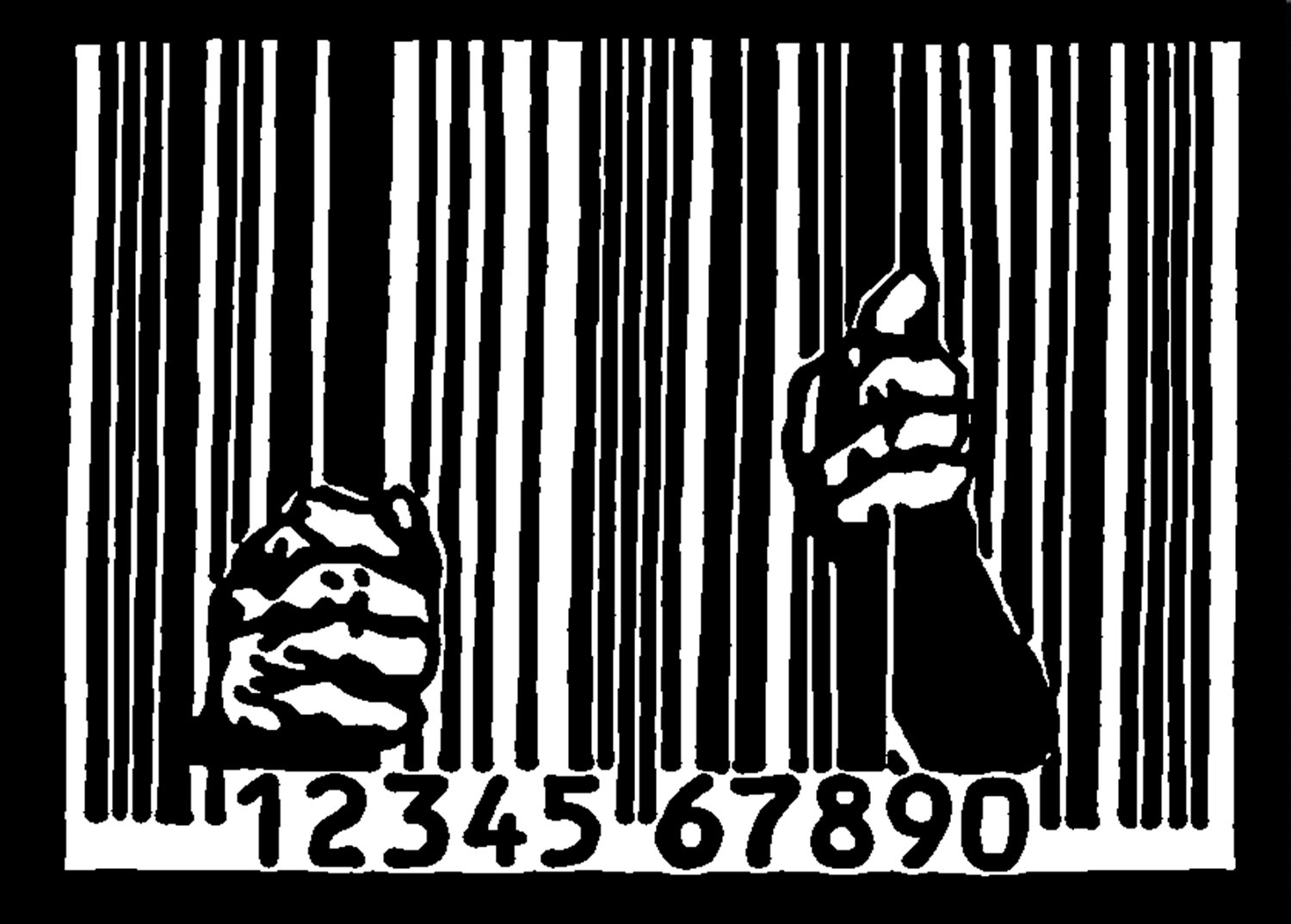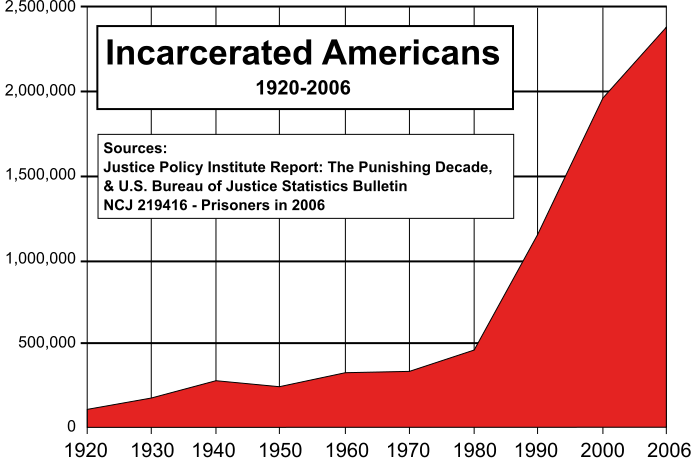
[Illustration by SHEPARD FAIREY]
CORRECTIONS CORPORATION OF AMERICA 2010 ANNUAL REPORT: The demand for our facilities and services could be adversely affected by the relaxation of enforcement efforts, leniency in conviction or parole standards and sentencing practices or through the decriminalization of certain activities that are currently proscribed by our criminal laws. For instance, any changes with respect to drugs and controlled substances or illegal immigration could affect the number of persons arrested, convicted, and sentenced, thereby potentially reducing demand for correctional facilities to house them. Legislation has been proposed in numerous jurisdictions that could lower minimum sentences for some non-violent crimes and make more inmates eligible for early release based on good behavior. Also, sentencing alternatives under consideration could put some offenders on probation with electronic monitoring  who would otherwise be incarcerated. Similarly, reductions in crime rates or resources dedicated to prevent and enforce crime could lead to reductions in arrests, convictions and sentences requiring incarceration at correctional facilities. MORE
who would otherwise be incarcerated. Similarly, reductions in crime rates or resources dedicated to prevent and enforce crime could lead to reductions in arrests, convictions and sentences requiring incarceration at correctional facilities. MORE
JUSTICE POLICY INSTITUTE: While private prison companies may try to present themselves as just meeting existing demand for prison beds and responding to current market conditions, in fact they have worked hard over the past decade to create markets for their product. As revenues of private prison companies have grown over the past decade, the companies have had more resources with which to build political power, and they have used this power to promote policies that lead to higher rates of incarceration. For-profit private prison companies primarily use three strategies to influence policy: lobbying, direct campaign contributions, and building relationships, networks, and associations. MORE
PREVIOUSLY: Study Calls Bullshit On The Private Prison Industrial Complex
RELATED: “Prison–industrial complex” (PIC) is a term used to attribute the rapid expansion of the US inmate population owing to the political influence of private prison companies and businesses that supply goods and services to government prison agencies. The term is analogous to the military–industrial complex that President Dwight D. Eisenhower warned of in his famous 1961 farewell address. Such groups include corporations that contract prison labor, construction companies, surveillance technology vendors, lawyers, and lobby groups that represent them. Activists have described the prison industrial complex as perpetuating a belief that imprisonment is a quick fix to underlying social problems such as homelessness, unemployment, drug addiction, mental illness, and illiteracy. The promotion of prison building as a job creator and the use of inmate labor are also cited as elements of the prison industrial complex. The term often implies a network of actors who are motivated by making profit rather than solely by punishing or rehabilitating criminals or reducing crime rates. Proponents of this view believe that the desire for monetary gain has led to the growth of the prison industry and the number of incarcerated individuals. These views are often shared by people who fear or condemn excessive use of power by government, particularly when related to law enforcement and military affairs. MORE
THE ATLANTIC: On January 17, 1961, President Dwight D. Eisenhower used his farewell address to issue a warning, as the United States continued its cold war with the Soviet Union. “In the councils of government,” Eisenhower said, “we must guard against the acquisition of unwarranted influence, whether sought or unsought, by the military-industrial complex.” Eisenhower had grown concerned about this new threat to democracy during the 1960 campaign, when fears of a “missile gap” with the Soviet Union were whipped up by politicians, the press, and defense contractors hoping for increased military spending. Eisenhower knew that no missile gap existed and that fear of one might lead to a costly, unnecessary response. “The potential for the disastrous rise of misplaced power exists and will persist,” Eisenhower warned. “We should take nothing for granted.”
Three decades after the war on crime began, the United States has developed a prison-industrial complex — a set of bureaucratic,  political, and economic interests that encourage increased spending on imprisonment, regardless of the actual need. The prison-industrial complex is not a conspiracy, guiding the nation’s criminal-justice policy behind closed doors. It is a confluence of special interests that has given prison construction in the United States a seemingly unstoppable momentum. It is composed of politicians, both liberal and conservative, who have used the fear of crime to gain votes; impoverished rural areas where prisons have become a cornerstone of economic development; private companies that regard the roughly $35 billion spent each year on corrections not as a burden on American taxpayers but as a lucrative market; and government officials whose fiefdoms have expanded along with the inmate population. Since 1991 the rate of violent crime in the United States has fallen by about 20 percent, while the number of people in prison or jail has risen by 50 percent. MORE
political, and economic interests that encourage increased spending on imprisonment, regardless of the actual need. The prison-industrial complex is not a conspiracy, guiding the nation’s criminal-justice policy behind closed doors. It is a confluence of special interests that has given prison construction in the United States a seemingly unstoppable momentum. It is composed of politicians, both liberal and conservative, who have used the fear of crime to gain votes; impoverished rural areas where prisons have become a cornerstone of economic development; private companies that regard the roughly $35 billion spent each year on corrections not as a burden on American taxpayers but as a lucrative market; and government officials whose fiefdoms have expanded along with the inmate population. Since 1991 the rate of violent crime in the United States has fallen by about 20 percent, while the number of people in prison or jail has risen by 50 percent. MORE

RELATED: The White House has issued a press release that President Barack Obama would nominate Michele M. Leonhart to head the Drug Enforcement Administration. Leonhart is a career law enforcement officer and was appointed by George W. Bush in 2003 as the Deputy Administrator in the DEA. Some critics of the Leonhart nomination say that reaffirming Bush policies by retaining his worst appointees is disappointing to say the least. Leonhart was front and center during the federal closing of California dispensaries during the Bush years. MORE
RELATED: As Special Agent in Charge (SAC) for the DEA office in Los Angeles under President George W. Bush, Ms. Leonhart was the ranking DEA agent responsible for numerous Bush Administration raids against medical marijuana patients and providers there. President Bush later made her acting DEA Administrator, a position she currently holds. Since the Obama Administration took office, the DEA has continued to raid medical marijuana patients and caregivers despite a directive issued by the U.S. Justice Department strongly discouraging federal law enforcement from using scarce resources to arrest and prosecute those acting in compliance with  their state’s medical marijuana laws. MORE
their state’s medical marijuana laws. MORE
RELATED: Additionally, Leonhart has links to the ongoing “House of Death” scandal and is directly tied to the Andrew Chambers / “Super Snitch”scandal. The “House of Death” in Juárez, Mexico, was a house used by the Juárez drug cartel to murder people. Dozens of bodies were eventually recovered when the police raided it. The case revolves around a U.S. Immigration and Customs (ICE) and DEA informant in Mexico, codenamed “Lalo,” who witnessed (and perhaps took part in) a murder in the House of Death during August 2003. In a lawsuit, whistleblower and former DEA Special Agent Sanalio Gonzalez charges that Leonhart and other officials fired him for speaking out about the murders and then helped cover the scandal up. MORE
RELATED: In the Andrews Chambers case, Ms. Leonhart reportedly continued to use a corrupt informant despite mounting evidence that he was a serial perjurer and ongoing thief and fraud. Mr. Chambers began working for the DEA in 1986 and, over the span of an almost 15 year career, received approximately $2.2 million in payments from the DEA, making him the most highly paid informant in DEA history. His primary role was to conduct sting operations, which resulted in hundreds of prosecutions. He was branded a perjurer by the US 8th and 9th Circuit Courts of Appeals and many prosecutors ceased to use him after they learned of his previous criminal convictions and his record for perjury. Michelle Leonhart had a close professional relationship with Chambers, continuously defending him, describing him as “an outstanding testifier.” MORE
RELATED: In a much-criticized move, Acting DEA administrator Michele Leonhart spent more than $123,000 to charter a private jet, instead of one of the DEA’s own 106 planes, to fly to Colombia two years ago. The level of disapproval would have been even higher if it had been known that the DEA chartered the jet from a contractor with a major investment in a shell company in Florida that owned a DC9 caught carrying 5.5 tons of cocaine in Mexico. “Just as the nation was reeling from the worst economic crisis in decades, with the national debt climbing toward $10 trillion, Leonhart chose an expensive outside jet charter company instead of one of the DEA’s own 106 planes for her trip to Bogotá, Colombia last fall,” reported Marisa Taylor of McClatchy Newspapers. In a Feb 16, 2009 story headlined “DEA official’s private charter cost $123,000,” Taylor reported that the DEA chartered the jet for Leonhart’s trip from L-3 Communications, which bills itself as the nation’s sixth largest defense contractor, and which made more than $32 million  from the DEA in 2008 for transportation services, while the company’s largest subsidiary, “Titan Group of L-3 Communications,” had a $70,000 investment in a shell company in Miami with no employees, no earnings and no prospects, but which somehow wound up as the true and legal owner of a DC9 carrying a cargo of 5.5 tons of cocaine. MORE
from the DEA in 2008 for transportation services, while the company’s largest subsidiary, “Titan Group of L-3 Communications,” had a $70,000 investment in a shell company in Miami with no employees, no earnings and no prospects, but which somehow wound up as the true and legal owner of a DC9 carrying a cargo of 5.5 tons of cocaine. MORE
RELATED: The DEA has way too much power in this world — over doctors, over medicine, over research, over local law enforcement, \over public policy — to leave in the hands of someone like Michele Leonhart. MORE
TIME: The DEA ruled that marijuana has “no currently accepted medical use in treatment in the United States,” has a “high potential for abuse,” and “lacks an acceptable level of safety for use even under medical supervision.” Not only does this decision conflict with state laws, however, it also conflicts with a 1999 report by the Institute of Medicine (IOM), the branch of the National Academy of Sciences charged with answering complex medical questions for Congress. Way back in 1999, the IOM said:
Scientific data indicate the potential therapeutic value of cannabinoid drugs, primarily THC, for pain relief, control of nausea and vomiting, and appetite stimulation; smoked marijuana, however, is a crude THC delivery system that also delivers harmful substances.
Despite the issue of smoking marijuana, the IOM said that medical use of the drug is acceptable when other alternatives have failed. In addition, in 2006 the U.S. Food and Drug Administration issued an investigational new drug application, or IND — which grants permission to study a drug with the goal of approving it for marketing if it is safe and effective — for Sativex, an inhalable marijuana-derived drug, which includes both THC and CBD, the main active components of cannabis. So, while one federal agency says the drug is too risky for use even under medical supervision, another is studying it for possible approval for marketing. The synthetic marijuana-based drugs nabilone and dronabinol (both used to treat nausea and vomiting) are already approved in the U.S. and have  been placed in Schedules II and III, respectively. Schedule II includes drugs with high abuse potential like Oxycontin, while Schedule III includes milder painkillers like codeine combined with Tylenol. Since the IOM report was released more than a decade ago, the evidence for the medical benefits of marijuana and related drugs has continued to increase. In the last three years alone, cannabinoids have been found to help kill breast cancer cells, fight liver cancer, reduce inflammation, have antipsychotic effects and even potentially help stave off the development of Alzheimer’s disease and reduce progression of Huntington’s disease. Further, a 2011 review of the effectiveness of cannabinoids for non-cancer pain found “no significant adverse effects” and “significant” analgesic effects. MORE
been placed in Schedules II and III, respectively. Schedule II includes drugs with high abuse potential like Oxycontin, while Schedule III includes milder painkillers like codeine combined with Tylenol. Since the IOM report was released more than a decade ago, the evidence for the medical benefits of marijuana and related drugs has continued to increase. In the last three years alone, cannabinoids have been found to help kill breast cancer cells, fight liver cancer, reduce inflammation, have antipsychotic effects and even potentially help stave off the development of Alzheimer’s disease and reduce progression of Huntington’s disease. Further, a 2011 review of the effectiveness of cannabinoids for non-cancer pain found “no significant adverse effects” and “significant” analgesic effects. MORE
